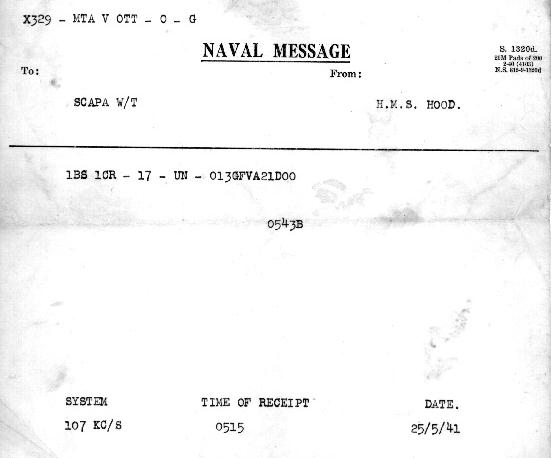 |
| This is the last radio message from HMS HOOD to the Admiralty wireless station at Scapa Flow, Scotland. HOOD was sunk at 0553 on May 24, 1941. |
HMS HOOD - LAST RADIO MESSAGES In mid-1999, an ex-RCN Sparker passed away. In his files, his widow found these historical messages and donated them to the SPARC Radio Museum.
 |
| This is the last radio message from HMS HOOD to the Admiralty wireless station at Scapa Flow, Scotland. HOOD was sunk at 0553 on May 24, 1941. |
J.A. Charles was a signal officer in HMCS Restigouche, escorting troop convoy WS 8, 200 miles south of the Bismarck on 26 May 1941. At the time he was a qualified Long Signal Officer and a future C.O. of HMCS Haida. Here is the explanation:
1. The 107 Kcs under SYSTEM in the message indicates that these messages were received on the area shore to ship broadcast and are messages sent in morse code and written out and typed in a W/T office. The TIME OF RECEIPT is when it was received in that office.2. At the top of the first message X329 is an operating signal from the old RN W/T operating code directing Ottawa to pass to another military authority. This RN W/T operating code has been replaced by the current international Q code.
3. The original enemy sighting report would have been prepared on the Flag Bridge of Hood and probably keyed from a remote site on the bridge by a staff telegraphist. The transmitter would have been set on a ship shore frequency, (4 mc/s or 6 mc/s). The tel would key a call to any RN shore station with an uncoded call sign. He would use a coded call sign to identify Hood as the sender in the message he transmitted.
4. The enemy sighting report was in P/L. ie. 1 BS, 1 CR- 17 miles, course and speed unknown, my position bearing 013 from geographical position GFVA distance 21 miles , coded authentication DOO –indicating that this is not a phony message. The time of dispatch is 0543 B. The B indicates 2 hours before GMT (Z). The British kept double summer time during the war.
5. This message would have been received at a shore station, possibly more than one, but whichever one gave R. In this case Scapa WT who immediately sent it to Admiralty , and since C-in-C H.F. was at sea it would have been broadcast on the area broadcast serving the Eastern Atlantic and repeated 4 hours later. As there were at least 5 convoys at sea, and the battleships Ramillies and Revenge in the western Atlantic, these messages were broadcast on the Halifax transmitter (now at Newport Corner) on 107 kc/s for that area.
6. NB. There was no “Flash” priority at this time, this original message would have O-U marking most immediate. Thus every warship at sea in the Atlantic would have received these messages in morse code in their W/T office and the call sign would have to be decoded. What the telegraphists wrote or typed on the message form may have some variation including the time, date of receipt and the message may have been typed and distributed by signal distribution office.
7. The message from S.O. CS 1 (ie. the Admiral commanding the 1st Cruiser Squadron) was in the cruiser Norfolk, this would have been from a 3 letter encrypted call sign.
8. The use of 4 letter geographical positions was designed to give some tactical security and greatly reduce the time and possible error in transmitting latitude and longitude. It was very useful for routing convoys and escort rendezvous.
 |
| Less than two hours later, the situation has changed drastically as evidenced in the message from Scapa Flow. |
Scans of these messages were provided courtesy of Bruce Macmillan of the SPARC Museum.